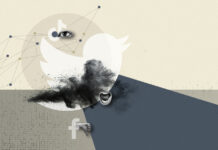“My friend Stefan is a painter,” says Klaas Heufer-Umlauf, who is world-famous in Germany as part of the “Joko and Klaas” duo: “Well, not someone who paints walls and masks something, but a crazy painter who in his studio goes and paints all night.”
The three-quarter hour film documenting the TV presenter’s visit to his artist friend’s studio can be found on the website of Galerie Haverkampf Leistenschneider, which – only founded five years ago – is now showing its fourth show with Stefan Hirsig. In his black shirt, splashed with decorative white paint, he does indeed correspond to the common image of a painter. With his neat appearance, one could also imagine Hirsig as the not-at-all-ascetic brother Tuck in the 1984 television series Robin Hood.
Hirsig, born in 1966, could have noticed the series at the time. If it’s true – and of course it does what the curator Harriet Zilch wrote to him in the catalog published on the occasion of the exhibition, namely that painting is not a one-dimensional model for explaining the world, but rather leaves blank spaces for new associative spaces and fields of reference – then Hirsig should be able to make the association don’t take offense any further. After all, he titled his exhibition “Monk”, as did two of the 13 pictures, and another is called “Monk”. A viewer might also see a TV presenter or a newspaper journalist looking at the pictures, just like a friar. Or not.
They are brightly colored, highly dynamic, gestural abstractions that are reminiscent of the Neue Wilde of the 1980s. In fact, Hirsig studied at what was then the University of the Arts with Bernd Koberling. A greater contrast could not be imagined to the impeccably lacquered minimalism of a Gerold Miller, presented at the same time around the corner in the Wentrup Gallery. In a few weeks, at Art Basel, it will be possible to find out whether the dealers this year are focusing a little more on video, photography, or installation art, or rather – that would be a safe bet – painting. In any case, what also applies to fashion has long since applied to art: Anything goes.
Anything goes, even with the titles of Stefan Hirsig’s pictures (between 155 x 135 centimeters and 290 x 260 centimeters, 15,000 to 29,000 euros): “Good wins”, “The best for last” or even “The oracle speaks”. It speaks with two hands, eyes are also recognizable in the arrangement made up of many layers, that is: disorder. Those black curling lines… is he quoting Picasso?
The gallery owner Carolin Leistenschneider also wants to recognize references to Goya and Grosz, Bacon and Beckmann. Zilch sees Pollock and Polke and that, under these conditions, the distinction between abstraction and figuration is no longer relevant. Under these conditions: craquelé-like cracks and groove structures like on a record combine with the trompe-l’oeil of indicated 3D effects to compositions that can hardly be increased in density. Two pictures each come from the years 2007 and 2008, nine are fresh from the studio – they can be assigned immediately based on the increase in density achieved over the past 15 years.


















